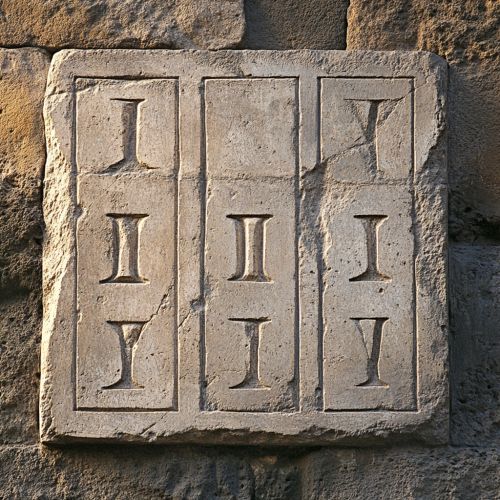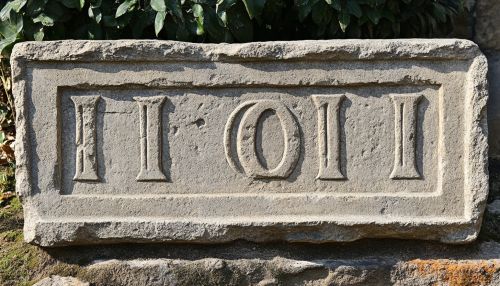Roman numeral system
Introduction
The Roman numeral system is a numeral system originating in ancient Rome, employing combinations of letters from the Latin alphabet to signify values. This system was the standard method of writing numbers throughout the Roman Empire and remained in use in Europe well into the Middle Ages. Today, Roman numerals are primarily used in specific contexts, such as in the naming of monarchs and popes, on clock faces, and in the enumeration of book chapters and movie sequels.
Historical Context
The Roman numeral system evolved from the Etruscan numeral system, which itself was influenced by the Greek numeral system. The earliest forms of Roman numerals can be traced back to around the 7th century BCE. The system was developed to meet the needs of a society that required a method for counting and recording transactions, particularly in trade and commerce. The Roman numeral system is non-positional, meaning that the value of a numeral is not affected by its position in the sequence, unlike the Hindu-Arabic numeral system.
Numerals and Their Values
The Roman numeral system uses seven basic symbols: I, V, X, L, C, D, and M. Each symbol represents a specific value:
- I = 1
- V = 5
- X = 10
- L = 50
- C = 100
- D = 500
- M = 1000
These symbols can be combined to create other numbers. For example, the number 2 is written as II, and the number 12 is written as XII. The system is additive and subtractive; smaller numbers placed before larger numbers indicate subtraction, while those placed after indicate addition. For instance, IV represents 4 (5 - 1), and VI represents 6 (5 + 1).
Rules and Conventions
The Roman numeral system follows specific rules and conventions:
1. **Repetition**: A numeral can be repeated up to three times to add up to a larger number. For example, III is 3, and XXX is 30. However, the numeral V, L, and D are never repeated.
2. **Subtractive Notation**: When a smaller numeral precedes a larger numeral, it is subtracted. For example, IV is 4, and IX is 9.
3. **Additive Notation**: When a smaller numeral follows a larger numeral, it is added. For example, VI is 6, and XI is 11.
4. **Non-Repetition of V, L, D**: The numerals V, L, and D are not repeated because they are derived from the Etruscan system, where each represented a specific hand gesture or tally mark.
5. **Order of Numerals**: Numerals are arranged from largest to smallest from left to right. For example, the number 73 is written as LXXIII.
Applications and Usage
Roman numerals are used in various modern contexts:
- **Chronology**: They are used to denote years, especially in the context of historical events and the reigns of monarchs and popes, such as King Louis XIV or Pope John Paul II.
- **Clocks and Watches**: Many traditional clock faces use Roman numerals to mark the hours.
- **Literature and Film**: Roman numerals are often used to denote volumes, chapters, and sequels, such as in book series or movie franchises.
- **Architecture and Monuments**: Inscriptions on buildings and monuments frequently use Roman numerals to indicate dates.
- **Mathematics and Science**: Although less common, Roman numerals are sometimes used in scientific contexts, particularly in chemistry to denote oxidation states.


Limitations and Challenges
The Roman numeral system, while historically significant, has several limitations:
- **Lack of Zero**: The system does not include a symbol for zero, making it less efficient for calculations compared to the Hindu-Arabic numeral system.
- **Complexity in Large Numbers**: Writing and interpreting large numbers can be cumbersome. For example, the number 1987 is written as MCMLXXXVII.
- **Non-Positional Nature**: The non-positional nature of Roman numerals makes arithmetic operations like addition, subtraction, multiplication, and division more complex.
Evolution and Decline
The decline of the Roman numeral system began with the rise of the Hindu-Arabic numeral system, which was introduced to Europe through the works of mathematicians such as Fibonacci. The Hindu-Arabic system's efficiency, particularly its use of zero and positional notation, led to its widespread adoption in trade, science, and mathematics.
Modern Relevance
Despite its limitations, the Roman numeral system remains relevant in certain cultural and ceremonial contexts. It is often used to confer a sense of tradition and formality. In addition, the system's historical significance continues to be a subject of study in the fields of archaeology, history, and linguistics.
